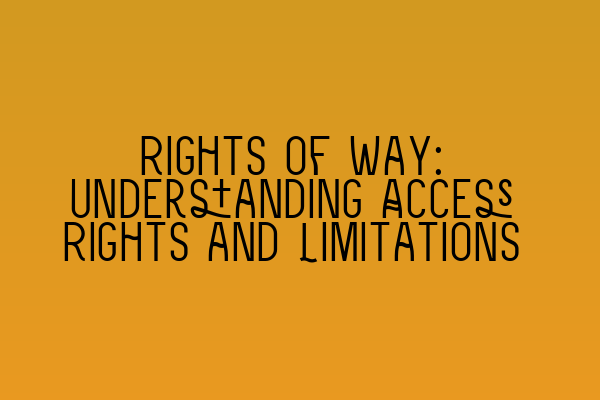At SQE Property Law & Land Law, we understand the importance of rights of way and the impact they can have on property ownership and land use. Whether you are a property owner, tenant, or investor, it is crucial to have a clear understanding of access rights and limitations to avoid conflicts and legal disputes.
What Are Rights of Way?
A right of way refers to the legal right to pass through another person’s property for a specific purpose. It provides an easement that allows an individual or a group of individuals to travel across private land. It is important to note that rights of way can be granted explicitly or impliedly.
Explicit rights of way are typically established through a legal agreement, such as a deed or a contract. They define the specific terms and conditions under which the right may be exercised, including the purpose of the access, the scope of the right, and any limitations or restrictions.
Implied rights of way, on the other hand, are not explicitly stated but are inferred from the circumstances and the historical use of the land. For example, if a property has been accessed through a certain route for a long period of time without any objections, an implied right of way may be established.
Types of Rights of Way
There are several types of rights of way, each with its own characteristics and implications:
- Public Rights of Way: These are rights of way that are granted to the general public and are typically used for public access, such as footpaths, bridleways, and byways. Public rights of way are usually recorded and protected by law.
- Private Rights of Way: These are rights of way that are granted to specific individuals or groups and are limited to their use only. Private rights of way can be established through explicit agreements or historical use.
- Prescriptive Rights of Way: These are rights of way that are acquired through uninterrupted and continuous use for a specified period of time, usually 20 years or more. Prescriptive rights of way can be established even if there is no explicit agreement.
- Easements: These are rights of way that are attached to a property and pass with the property when it is sold or transferred. Easements can be either express or implied and can be created by agreement or by necessity.
Limitations and Restrictions
While rights of way provide valuable access to properties and land, they are subject to certain limitations and restrictions:
- Scope and Purpose: The scope of a right of way is determined by its purpose. For example, a right of way for pedestrian access may not allow for vehicular access. It is crucial to understand the specific purpose and scope of the right to avoid any potential conflicts.
- Maintenance Responsibilities: The responsibility for maintaining a right of way is typically shared between the property owner and the user. It is important to determine the maintenance obligations and responsibilities upfront to avoid disputes.
- Alterations and Improvements: Any alterations or improvements to a right of way may require the consent of all parties involved. It is important to seek legal advice before making any changes to ensure compliance with the terms and conditions of the right.
- Termination: Rights of way can be terminated if the purpose for which they were granted no longer exists, or if there has been a significant change in circumstances. It is important to be aware of the circumstances that may lead to the termination of a right of way.
Consult with a Property Law Expert
Understanding rights of way and their limitations is crucial for anyone involved in property ownership, land use, or investment. At SQE Property Law & Land Law, our team of experienced property law solicitors can provide you with expert advice and guidance on rights of way and other property-related matters. Contact us today to schedule a consultation.
Related Articles:
